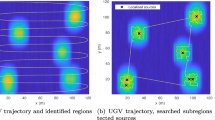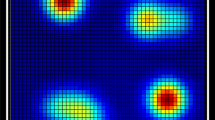Abstract
This paper addresses the design of lightweight radiation sensors for the small-scale unmanned aerial system (UAS) and its implementation for low-altitude radiation source localization and contour mapping. The compact high-resolution gamma-ray CZT sensors were integrated into UAS platforms as plug-and-play components using robot operating system. The swarm of UAS has advantages over a single agent-based approach in detecting radiative sources and effectively mapping the area. The proposed swarm consists of three UAS platforms in a circular formation. The proposed approach can potentially be used for low-altitude clustered environments where a conventional helicopter-based platform cannot be utilized. It can provide a relatively precise boundary of the safe area for potential human exploration as well as enhancing situation awareness capabilities for first responders. The source seeking and contour mapping algorithms are developed based on a simple 1/R2 radiation field, but they are validated in more realistic radiation field having multiple sources and physical structures with scattering and attenuation effects simulated by MCNP code. Also, gradient estimation and contour mapping algorithms are validated experimentally with small-scale multicopter platforms in the indoor flight testbed.

















Similar content being viewed by others
References
Gilbertson M (2013) US Department of Energy (DOE), experience and strategic lessons learned from decommissioning and remediation of large nuclear legacy sites. In: International experts’ meeting on decommissioning and remediation after a nuclear accident
Sen TK, Moore LJ (2000) An organizational decision support system for managing the DOE hazardous waste cleanup program. Decis Support Syst 29(1):89
Brewer ET (2009) Autonomous localization of 1/R 2 sources using an aerial platform autonomous localization of 1/R 2 sources using an aerial platform. M.S. Thesis, Virginia Polytechnic Institute and State University
Sepulchre R, Paley DA, Leonard NE (2007) Stabilization of planar collective motion: all-to-all communication. IEEE Trans Automat Control 52(5):811–824
Leonard NE, Paley DA, Lekien F, Sepulchre R, Fratantoni DM, Davis RE (2007) Collective motion, sensor networks, and ocean sampling collective motion, sensor networks, and ocean sampling. Proc IEEE 95(1):48–74
Raffard RL, Tomlin CJ, Boyd SP, Formulation AP (2004) Distributed optimization for cooperative agents: application to formation flight. IEEE Conf Decis Control 3:2453–2459
Marshall JA, Broucke ME, Francis BA (2004) Formations of vehicles in cyclic pursuit. IEEE Trans Automat Control 49(11):1963–1974
Ogren P, Egerstedt M, Hu X (2002) A control Lyapunov function approach to multiagent coordination. IEEE Trans Robot Autom 18(5):847–851
Arranz LB, Seuret A, De Wit CC (2009) Translation control of a fleet circular formation of AUVs under finite communication range. Proc IEEE Conf Decis Control 98:8345–8350
Moore BJ, Canudas-de-Wit C (2010) Source seeking via collaborative measurements by a circular formation of agents. In: American control conference (ACC)
Cortez RA, Tanner HG (2008) Radiation mapping using multiple robots. Trans Am Nucl Soc 99:157–159
Han J, Chen Y (2014) Multiple UAV formations for cooperative source seeking and contour mapping of a radiative signal field. J Intell Robot Syst 74(1–2):323–332
Cui R, Li Y, Yan W (2016) Mutual information-based multi-AUV path planning for scalar field sampling using multidimensional RRT. IEEE Trans Syst Man Cybernet Syst 46(7):993
Hitz G, Galceran E, Garneau M, Pomerleau F (2017) Adaptive continuous-space informative path planning for online environmental monitoring. J Field Robot 34:1427–1449
https://www.kromek.com/index.php/products/nuclear-technology/czt/gr1a
Kazemeini M, Barzilov A, Yim W, Lee J (2018) Integration of CZT and CLYC radiation sensors into a UAS platform. In: Proceedings of conference on sensors and electronic instrumentation advances (SEIA’18), Amsterdam, Netherlands, pp 57–59. 19–21 Sept 2018
Kazemeini M, Cook Z, Lee J, Barzilov A, Yim W (2018) Plug-and-play radiation sensor components for unmanned aerial system platform. J Radioanal Nucl Chem 318:1797–1803
Ogren P, Fiorelli E, Leonard NE (2004) Cooperative control of mobile sensor networks: adaptive gradient climbing in a distributed environment. IEEE Trans Automat Control 49(8):1292–1302
Uryasev S (1995) Derivatives of probability functions and some applications. Ann Oper Res 56(1):287–311
Goorley T (2012) Initial MCNP6 release overview. Nucl Technol 180(3):298–315
Acknowledgements
This work is supported by a Grant from Savannah River Nuclear Solutions, LLC under Contract No. 0000217400 and by the National Science Foundation’s PFI Program, Grant No. 1430328.
Author information
Authors and Affiliations
Corresponding author
Additional information
Publisher's Note
Springer Nature remains neutral with regard to jurisdictional claims in published maps and institutional affiliations.
Electronic supplementary material
Below is the link to the electronic supplementary material.
Rights and permissions
About this article
Cite this article
Cook, Z., Kazemeini, M., Barzilov, A. et al. Low-altitude contour mapping of radiation fields using UAS swarm. Intel Serv Robotics 12, 219–230 (2019). https://doi.org/10.1007/s11370-019-00277-8
Received:
Accepted:
Published:
Issue Date:
DOI: https://doi.org/10.1007/s11370-019-00277-8




